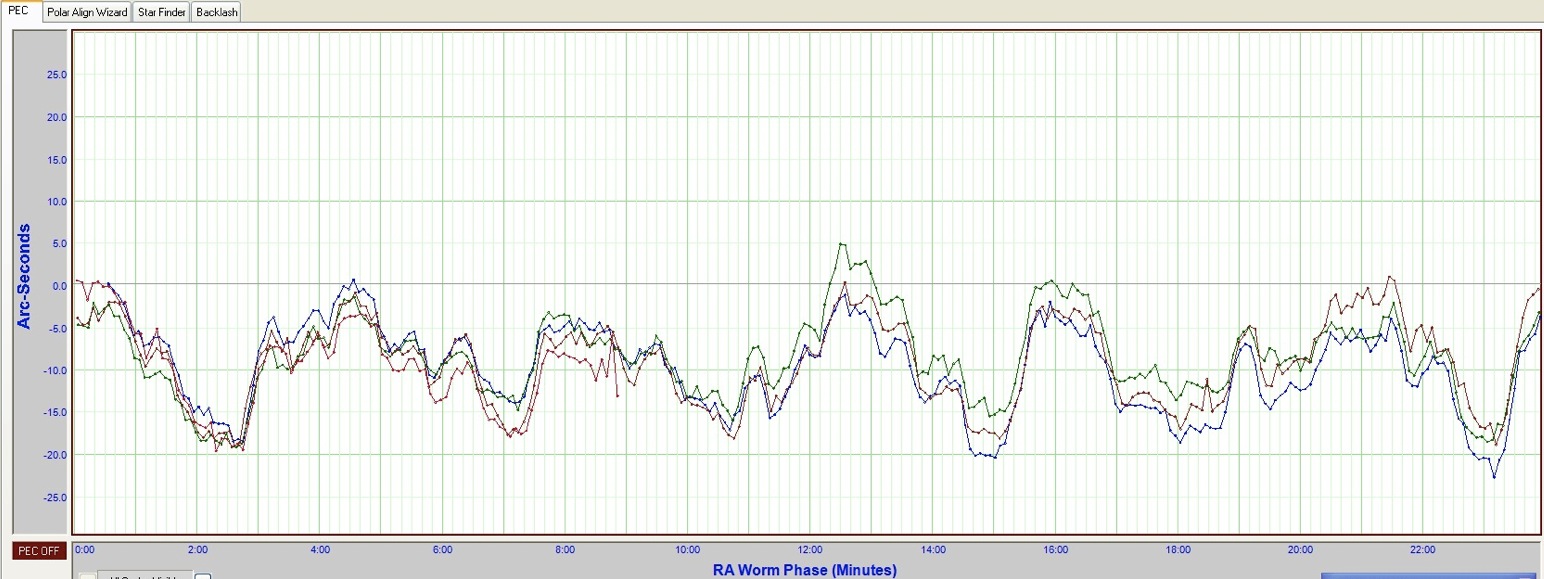"PemPro" stands for periodic error management, professional. PemPro, written by Ray Gralak and sold by CCDWare, is software that measures, analyzes, and corrects the periodic error occurring in almost all telescope mounts (including all that use gears in the drive train). Periodic errors are those errors in the gears as they repeat; slight imperfections in the machining of the gear teeth, slight changes in the distance between teeth, and ellipticity (or oblicity) of the gear itself can all cause errors which repeat every turn of the gear. PemPro measures the periodic error by imaging a star over several cycles (revolutions) of the gear system, and looking at the changes in position (pixels in the image) that repeat with each cycle of the gear. These cycles can then be decomposed into periodic components (Fourier analysis), and a smooth model of the curve developed. This model curve can then be inverted and used by the telescope mount and software (TheSky6) to correct for these periodic gear errors. The following image shows the basic PemPro set-up window, and the chart area used to plot the star positions as the mount tracks the star. |
 |
PemPro can be used with nearly any telescope mount, from amateur to professional. On the LX200 mount, I measured about 25-30 arcseconds periodic error peak-to-peak, which was corrected using PemPro down to about 8-10 arcseconds, as shown on the following images. While this is a great correction, 8-10 arcseconds is still too much when imaging stars at a plate scale of 0.5 arcseconds/pixel, as this would mean that stars would be blurred out to 15-20 pixels - i.e., bloated. A much better mount and/or corrections are needed for astrophotography at this plate scale. However, PemPro did an impressive job correcting even the relatively poor LX200 fork mount that my scope originally used (prior to taking the OTA off the mount and putting it on a Paramount ME). |
 |
 |
PemPro also did a good job correcting the periodic error on the Paramount ME, which started out about 6 arcseconds peak-to-peak, and was corrected to about 1 arcsecond peak-to-peak, as shown in the image below. As typical "seeing" is 1.5-3 arcseconds, an error or 1 arcsecond does not bloat the stars significantly. This is incredible performance for an amateur-class mount (which is also used professionally in many applications). |
 |
PemPro software also has a polar alignment function that I believe is the best and easiest way to polar align any telescope. Polar alignment is the process os aligning the rotational ("RA") axis of the telescope with the rotational axis of the earth; by doing this, the telescope can accurately track the stars, as the earh rotates, making them seem to stand still for the camera, and allowing long exposures without 'trails'. The conventional method of polar alignment is called "drift alignment". Here, the telescope is first pointed nearly South, and a star tracked; any motion of the star must be due to the East-West (azimuthal) direction of the telescope mount. Then, a star in the Eastern sky is tracked, any error being due to the North-South (elevational) axis of the telescope. In the "old days", astronomers used an eyepiece with lighted "reticle" (cross hair) and watched a star for 10-20 minutes, noting the amount and direction of drift, and hoping to correct the scope by moving the az-el controls. This had to be iterated a number of times, and was a painstaking process. With PemPro, once a star is found (typically in the 5-7 magnitude range), the software does the tracking and plots the drift of the star. What's really neat, however, is that with only a minute of tracking, the software can project out the error; if the error is large, it can be corrected immediately, without waiting many minutes. As the errors decrease, you need to wait longer times to have a reliable measure of the error (like 10 minutes). Using the PemPro polar alignment function, a mount can be aligned very well (to 1-2 arcminutes) within 30-45 minutes. PemPro utilizes the amount of motion and known star position to very accurately determine the error. It is a fun and useful program. Examples of stars tracked and alignment corrections made using PemPro are shown on the image below. While there is variation in the star position ("twinkling"), there is a very clear average that indicates the polar alignment error very precisely. |
 |
 |